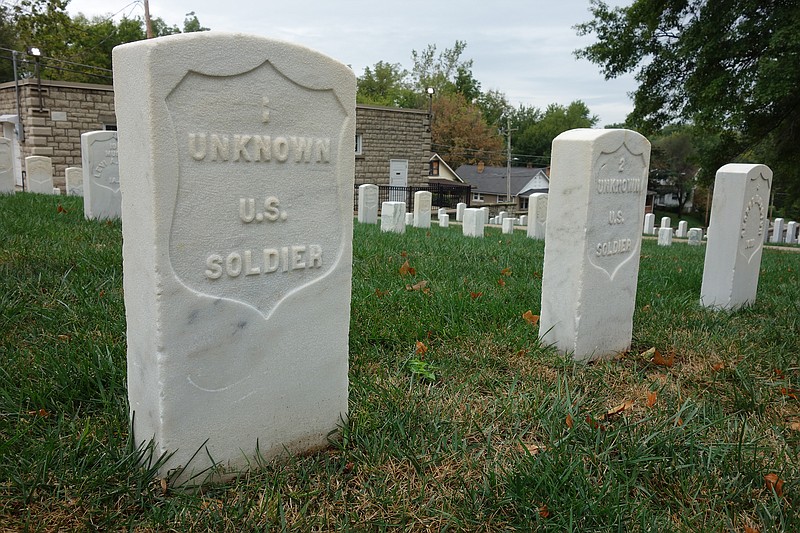Halloween is celebrated as the day the dead rise and walk among the living. But, what can modern residents learn from those taking a postmortem stroll through the Jefferson City area on All Hallows Eve if the deceased really did return to the streets?
The Jefferson City region is one of a complex history, both good and bad, but all of the people who lived and died here have lasting legacies that permeate into the world we live in today.
Disclaimer: The people named in this story are only a small portion of the historical figures hidden beneath the surface of Missouri's cemeteries. Many more stories and lessons from the past lie in waiting beneath the grass throughout Mid-Missouri.
Our tale begins on All Hallow's Eve
Among the most historically celebrated of Mid-Missouri's deceased, Father Ferdinand Helias, a man who brought religion to the frontier, rises from his grave in Taos recalling the simple log rectory and church yard in which the "Apostle of Central Missouri" collapsed and died of a stroke at age 78 some 143 years ago.
The Jesuit missionary came to Mid-Missouri from a wealthy Belgian family and began preaching in 1838 in Jefferson City. He made a lasting impression on the countryside, establishing seven Catholic churches and helping to form New Westphalia. Helias landed in Taos in 1842 and remained there until his 1874 death. An inscription on his grave partially reads, "After many ventures and labors on land and sea, God settled me in Missouri. The foundations of Westphalia were laid by me and seven churches were founded by me to the greater glory of God."
Serving the pioneers, Fr. Helias led a hard life. He slowly donated all his family riches, faced killer fevers and often slept outdoors in buffalo skins. During the Civil War, he was harassed and pillaged by both sides. If he could travel into Jefferson City, seeing his namesake, Helias High School, may make him feel appreciated as he retakes his mission, preaching the good word around the Missouri countryside.
"The Beverly Hillbillies" producer and screenwriter Paul Henning could give Fr. Helias a ride into town after he pulls himself from the Tuscumbia Cemetery dirt. However, Henning donated the Clampett truck to the Ralph Foster Museum before he died in 2005. Henning, an Independence native who helped create other television programs like "Petticoat Junction" and "Green Acres," would've been quite a sight rolling down U.S. 54 in that old rust bucket with Fr. Helias along in Granny's backseat rocking chair.
Like the hillbillies' old truck, the Rock Island Line railway is also long out of commission. It ran through Eldon near the long-gone Burris Hotel that helped inspire Henning to create "Petticoat Junction." Perhaps Henning's ghost would enjoy floating along the Rock Island Trail instead. If the project is approved by the state, Ameren Missouri could donate the old railway to create a nature trail so humans and spirits alike can enjoy the scenery that once inspired a silver screen legend.
Away from the countryside in the Capital City, unknown soldiers rise from the National Cemetery beneath the moonlight shadows of nameless tombstones, some still wearing Union uniforms from the Civil War's Centralia Massacre. Their duties finally complete, the veterans can lumber toward the spirits of families left long ago when they marched to war, through paved streets lined with electric lights that no longer seem to be their own.
Among the company of nameless soldiers walks two men whose names are etched into Missouri's history. Governors Thomas Reynolds and John S. Marmaduke had difficulty deciding who was in charge as they arose beside each other in the National Cemetery, because both men died as the reigning Missouri governor, though 43 years apart.
Reynolds (memorialized through Reynolds County), a lawyer, would be the corpse with a lowly disposition, having killed himself in the governor's mansion in 1844 during a fit of "melancholia." He was known as a proponent for limited government and for presiding over a period of economic growth. He also believed slavery was an issue for individual states to decide and called for the imprisonment of those who helped free slaves.
As fate would have it, he was replaced in the governor's office by none other than Meredith M. Marmaduke, an ancestor of John S. Marmaduke, the military man buried beside Reynolds. The senior Marmaduke led a charge for mental illness health care in Reynold's memory, which resulted with the opening of Fulton State Hospital.
Gov. John S. Marmaduke will likely be walking with a bit more confidence, for a zombie anyway. He was known as the Confederate officer who killed his superior in a duel before the Civil War even ended. After gaining state popularity as a foe of wealthy railroad companies, he won the governorship on a campaign that apologized for his Confederate involvement while sympathizing with Confederate policies. He went on to become known for breaking up labor disputes and preventing the spread of plague in livestock. He served as governor from 1885-87, before dying of pneumonia. For all his efforts, Marmaduke, Arkansas, was named in his honor.
The governors walk side-by-side down McCarty Street to see the 100-year-old Capitol, built too recently for either to have walked through when living.
The duo pass a man covered in dust after busting out of his family's mausoleum. The entrepreneur and former state legislator asks the governors, "Have you seen my statue?" He is Joseph Marcus Clarke, former president of the First National Bank of Jefferson City, who donated land for the first city hall and now wonders through Halloween nights looking for the bronze statue of his likeness that was supposed to reside in the hall indefinitely. It remained there until Jefferson City constructed a new municipal building and moved Clarke's effigy to a place named in his honor, the Clarke Nutrition Center.
As most of the undead depart the National Cemetery, a mother named Violet Ramsey remains behind, frantically searching for her children around her headstone imprinted with a rose - symbolic of love and hope. Lost somewhere in the graveyard, the tombstones of her children were overtaken by the decades, among hundreds of other lost markers and graves. Her husband, Elijah, quickly digs himself out to try and calm Violet. Perhaps the children are still at the old home place, he suggests.
As they leave the cemetery, six members of the United States Colored Infantry arise from the once segregated section of the cemetery before weathered government-issued grave markers, watching the couple with great interest.
Violet and Elijah were former slaves owned by one of Jefferson City's first settlers, Josiah Ramsey. Violet was freed around 1836 and worked washing laundry until she earned enough to purchase her husband and son's freedom. The family labored hard and somehow earned enough money to buy land - uncommon for black people at the time - building a log cabin on what was known as Hobo Hill.
Although Violet and Elijah led simple lives, the history that followed their home was anything but. The couple might have only made a gentle splash in their own time period, but it still ripples in today's waters. If it wasn't for the hard work that allowed them to purchase property on Hobo Hill, it isn't certain where the institutions that later existed there would be today.
After Violet and Elijah died, the first public school was built on the land that was their home after the local community struggled to obtain enough support to begin the public education system. This same little building later became the original schoolhouse of the Lincoln Institute for freed African-Americans, after the founders were turned away by two local churches.
Now, when Violet and Elijah get to their former home, they find Simonsen 9th Grade Center stands where they had built a small cabin. Their son, Elijah Jr., had already made it there, accompanied by the black Civil War soldiers from the National Cemetery.
Violet runs to hug her son, and looks to the soldiers standing before her with welcoming smiles. They all shared in the slowly gained spoils of their personal struggles for freedom and equality as Mid-Missouri evolved from its pioneer beginnings. Now, they watch from the top of Hobo Hill as fellow spirits of the past meander around, looking for where they belong in this modern world.
Although Violet and Elijah weren't students, the Ramseys have found their place among the fraternal heritage of the Lincoln Institute. The school opened for the special benefit of freed African-Americans. Now known as Lincoln University, it ranks 47th out of the nation's historically black colleges and universities in the 2018 U.S. News & World Report.
Remember those who came before us as we celebrate the spirits of the dead this Halloween. May they rest in peace the other 364 days of the year.
Cemetery Resource Board Chair Nancy Thompson contributed information for this article on the Ramseys, Clarke and the Lincoln Institute founders. Information in this article was also garnered from the Cole County Historic Society, "The House on Hobo Hill" by Jerena East Giffen, "The History of Lincoln University" by Sherman W. Savage, the Miller County Historical Society, St. Francis Xavier Catholic Church, the Saint Louis Catholic Historical Review, the Civil War Trust, the National Governors Association and Missouri State Archives.



